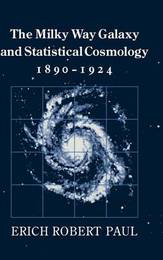
|
The Milky Way Galaxy and Statistical Cosmology, 1890-1924
Hardback
Main Details
| Title |
The Milky Way Galaxy and Statistical Cosmology, 1890-1924
|
| Authors and Contributors |
By (author) Erich Robert Paul
|
| Physical Properties |
| Format:Hardback | | Pages:280 | | Dimensions(mm): Height 229,Width 152 |
|
| Category/Genre | History of science
Cosmology and the universe |
|---|
| ISBN/Barcode |
9780521353632
|
| Classifications | Dewey:523.1 |
|---|
| Audience | | Professional & Vocational | |
|---|
|
Publishing Details |
| Publisher |
Cambridge University Press
|
| Imprint |
Cambridge University Press
|
| Publication Date |
26 November 1993 |
| Publication Country |
United Kingdom
|
Description
Between the years 1890 and 1924, the dominant view of the Universe suggested a cosmology largely foreign to contemporary ideas. First, astronomers believed they had confirmed that the Sun was roughly in the center of our star system, the Milky Way Galaxy. Second, considerable evidence indicated that the size of the Galaxy was only about one-third the value now accepted by today's astronomers. Third, it was thought that interstellar space was completely transparent, that there was no absorbing material between the stars. Fourth, astronomers believed that the Universe was composed of numerous star systems comparable to the Milky Way Galaxy. The method that provided this picture and came to dominate cosmology was 'statistical' in nature, because it was based on the counts of stars and their positions, motions, brightnesses, and stellar spectra. Drawing on previously neglected archival material, Professor Paul describes the rise of this statistical cosmology in light of developments in nineteenth-century astronomy and explains how this cosmology set the stage for many of the most significant developments we associate with the astronomy of the twentieth century. Statistical astronomy was the crucial link that provided much of modern astronimical science with its foundation.
Reviews'Paul's book, which will fill an important gap in the history of astronomy, may become the standard reference on its subject matter for a pivotal era.' Richard Berendzen, Journal for the History of Astronomy
|